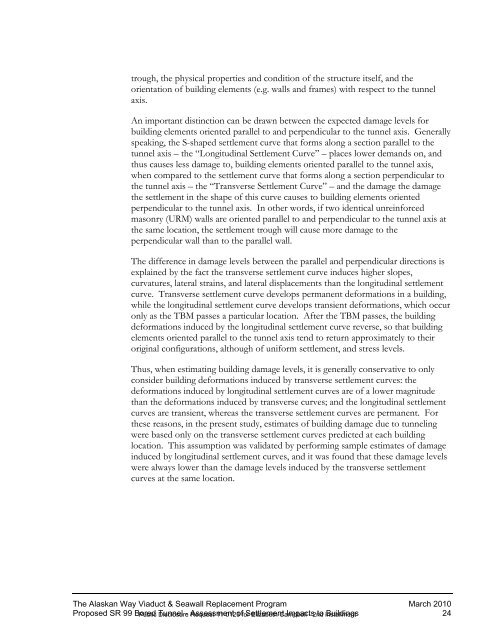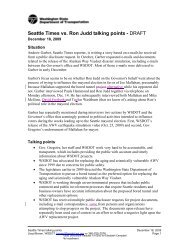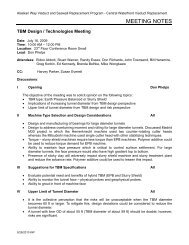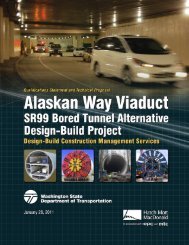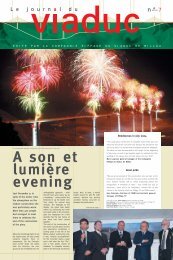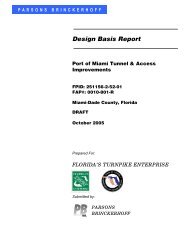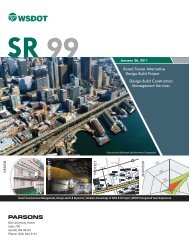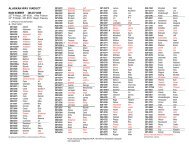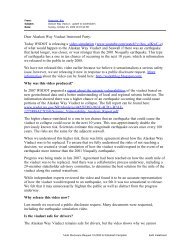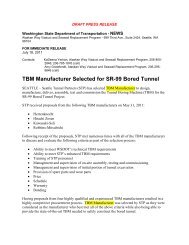SR99 Bored Tunnel-Assessment of Settlement Impacts ... - SCATnow
SR99 Bored Tunnel-Assessment of Settlement Impacts ... - SCATnow
SR99 Bored Tunnel-Assessment of Settlement Impacts ... - SCATnow
You also want an ePaper? Increase the reach of your titles
YUMPU automatically turns print PDFs into web optimized ePapers that Google loves.
trough, the physical properties and condition <strong>of</strong> the structure itself, and theorientation <strong>of</strong> building elements (e.g. walls and frames) with respect to the tunnelaxis.An important distinction can be drawn between the expected damage levels forbuilding elements oriented parallel to and perpendicular to the tunnel axis. Generallyspeaking, the S-shaped settlement curve that forms along a section parallel to thetunnel axis – the “Longitudinal <strong>Settlement</strong> Curve” – places lower demands on, andthus causes less damage to, building elements oriented parallel to the tunnel axis,when compared to the settlement curve that forms along a section perpendicular tothe tunnel axis – the “Transverse <strong>Settlement</strong> Curve” – and the damage the damagethe settlement in the shape <strong>of</strong> this curve causes to building elements orientedperpendicular to the tunnel axis. In other words, if two identical unreinforcedmasonry (URM) walls are oriented parallel to and perpendicular to the tunnel axis atthe same location, the settlement trough will cause more damage to theperpendicular wall than to the parallel wall.The difference in damage levels between the parallel and perpendicular directions isexplained by the fact the transverse settlement curve induces higher slopes,curvatures, lateral strains, and lateral displacements than the longitudinal settlementcurve. Transverse settlement curve develops permanent deformations in a building,while the longitudinal settlement curve develops transient deformations, which occuronly as the TBM passes a particular location. After the TBM passes, the buildingdeformations induced by the longitudinal settlement curve reverse, so that buildingelements oriented parallel to the tunnel axis tend to return approximately to theiroriginal configurations, although <strong>of</strong> uniform settlement, and stress levels.Thus, when estimating building damage levels, it is generally conservative to onlyconsider building deformations induced by transverse settlement curves: thedeformations induced by longitudinal settlement curves are <strong>of</strong> a lower magnitudethan the deformations induced by transverse curves; and the longitudinal settlementcurves are transient, whereas the transverse settlement curves are permanent. Forthese reasons, in the present study, estimates <strong>of</strong> building damage due to tunnelingwere based only on the transverse settlement curves predicted at each buildinglocation. This assumption was validated by performing sample estimates <strong>of</strong> damageinduced by longitudinal settlement curves, and it was found that these damage levelswere always lower than the damage levels induced by the transverse settlementcurves at the same location.The Alaskan Way Viaduct & Seawall Replacement Program March 2010Proposed SR 99 <strong>Bored</strong> <strong>Tunnel</strong> - <strong>Assessment</strong> <strong>of</strong> <strong>Settlement</strong> <strong>Impacts</strong> to Buildings 24Public Disclosure Request 11-0123 for Elizabeth Campbell - 2nd installment


